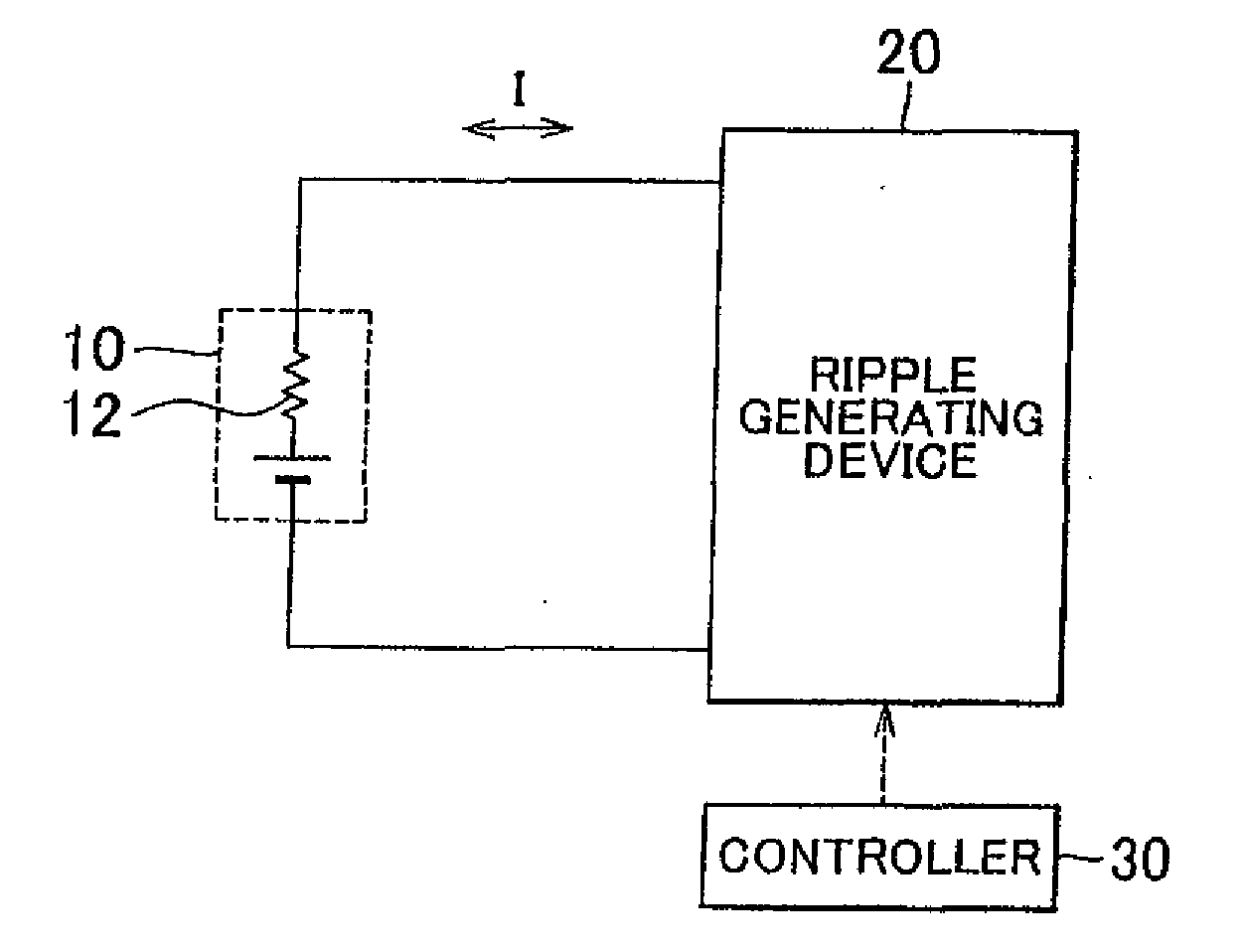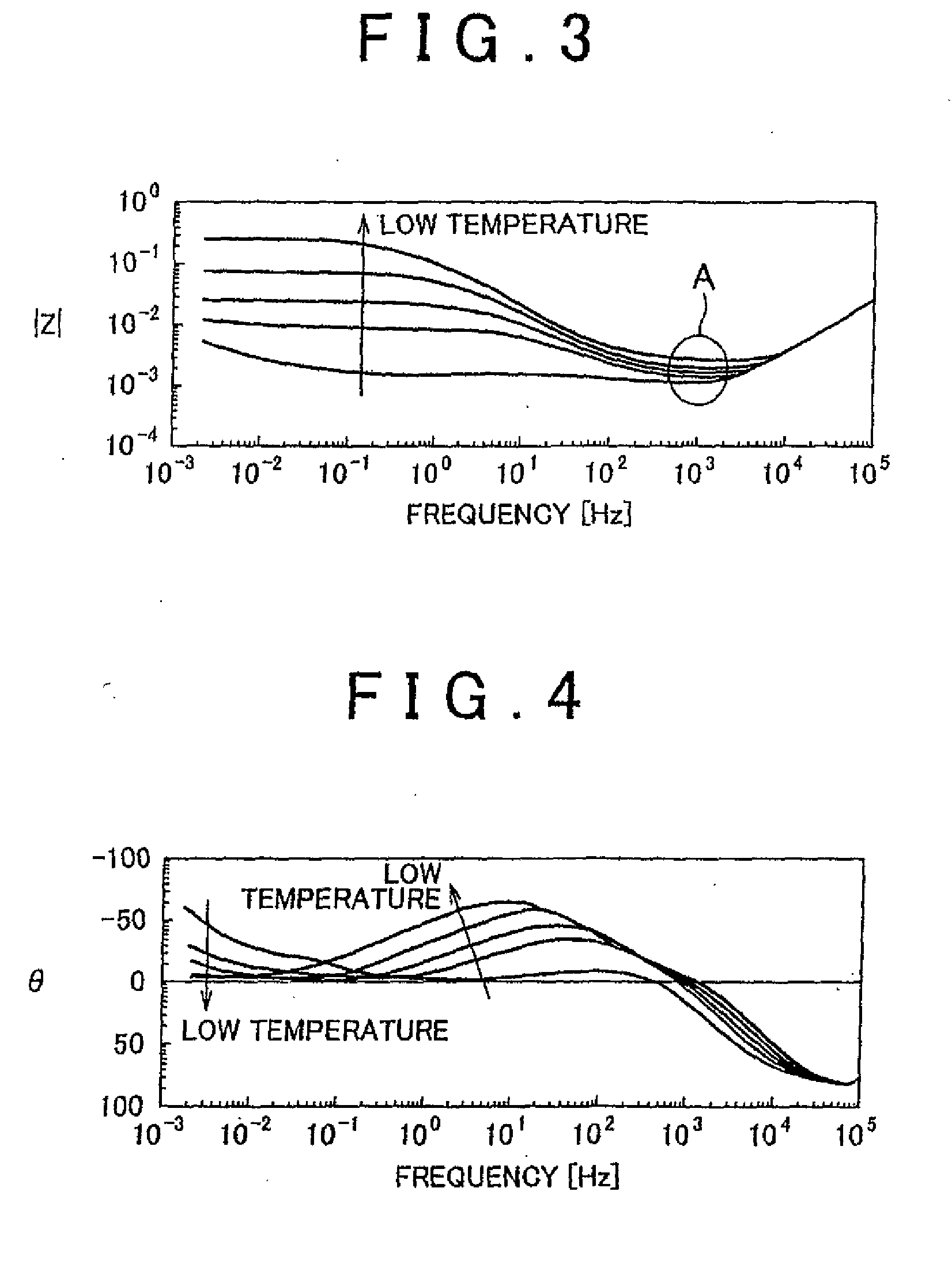Secondary battery temperature-increasing control apparatus, vehicle including the same, and secondary battery temperature-increasing control method
- Summary
- Abstract
- Description
- Claims
- Application Information
AI Technical Summary
Benefits of technology
Problems solved by technology
Method used
Image
Examples
first embodiment
[0049]FIG. 1 is a diagram for explaining a secondary battery temperature-increasing method of the invention. Referring to FIG. 1, the system includes a secondary battery 10, a ripple generating device 20, and a controller 30. The ripple generating device 20 is connected to the secondary battery 10.
[0050]The secondary battery 10 is a rechargeable battery, typified by a lithium ion battery or a nickel-hydrogen battery. The secondary battery 10 has an internal resistance 12. The internal resistance 12 has a temperature dependence and significantly varies depending also on the frequency of the electric current that flows in the battery as described later.
[0051]The ripple generating device 20 is controlled by the controller 30 and causes a ripple current I at a predetermined frequency to flow in the secondary battery 10. Thus, in the invention, a ripple current is caused to flow in the secondary battery to increase the temperature of the secondary battery from the inside thereof (such an...
second embodiment
[0108]In the second embodiment, a ripple frequency is selected, at which the allowable output power WoutB of the secondary battery 10 achieved when the ripple temperature increase operation is performed becomes maximum.
[0109]An overall configuration of a hybrid vehicle, in which a secondary battery temperature-increasing control apparatus according to the second embodiment is used, is the same as that of the hybrid vehicle 100 shown in FIG. 7.
[0110]FIG. 13 is a functional block diagram of part of the ECU 70A of the second embodiment, the part relating to the control of the boost converter 22. Referring to FIG. 13, the ECU 70A further includes a frequency range setting section 126 and a frequency selecting section 128 in addition to the components of the ECU 70 shown in FIG. 11. In addition, the ECU 70A includes a second calculating section 120A and a carrier generating section 124A instead of the second calculating section 120 and the carrier generating section 124.
[0111]The frequen...
third embodiment
[0133]In the second embodiment and the modification thereof, the ripple frequency is selected so that the allowable output power Wont of the secondary battery 10 achieved when the ripple temperature increase operation is performed becomes maximum. In a third embodiment, however, the frequency, at which it is ensured that the electric power required to start the engine 60 (FIG. 7) with the motor generator 56 (FIG. 7) is obtained, is selected as the ripple frequency. When the allowable output power WoutB corresponding to the selected ripple frequency is equal to or higher than the allowable output power WoutA, it is determined to perform the ripple temperature increase operation and, when the allowable output power WoutB is lower than the allowable output power WoutA, it is determined not to perform the ripple temperature increase operation.
[0134]FIG. 17 is a diagram showing the relation between the electric power required to start the engine and the temperature of the engine. Referri...
PUM
 Login to View More
Login to View More Abstract
Description
Claims
Application Information
 Login to View More
Login to View More - R&D
- Intellectual Property
- Life Sciences
- Materials
- Tech Scout
- Unparalleled Data Quality
- Higher Quality Content
- 60% Fewer Hallucinations
Browse by: Latest US Patents, China's latest patents, Technical Efficacy Thesaurus, Application Domain, Technology Topic, Popular Technical Reports.
© 2025 PatSnap. All rights reserved.Legal|Privacy policy|Modern Slavery Act Transparency Statement|Sitemap|About US| Contact US: help@patsnap.com



